- Performance: Despite September’s historical reputation as bitcoin’s weakest month, the asset surprised to the upside, significantly outperforming ether and most altcoins, but still diverging from gold’s strength. While short-term sentiment remains mixed, improving monetary policy and financial conditions are set to extend bitcoin’s structural bull market well into 2026.
- Macro: The Fed’s renewed easing cycle, set against rising inflation expectations and expanding global liquidity, points to a medium-term bullish backdrop for bitcoin. With real yields declining, money supply growth accelerating, and global growth expectations turning up, conditions are aligning for crypto assets to benefit meaningfully from looser financial conditions.
- On-Chain:Despite significant selling pressure by long-term holders, bitcoin remains relatively resilient due to ongoing outsized institutional demand and a decline in liquid supply (on exchanges). Bearish sentiment and on-chain metrics imply that sellers are becoming increasingly exhausted and signal that bitcoin might be in the process of bottoming out already.
Chart of the Month
Increasing stablecoin market caps are consistent w/ increasing macro liquidity
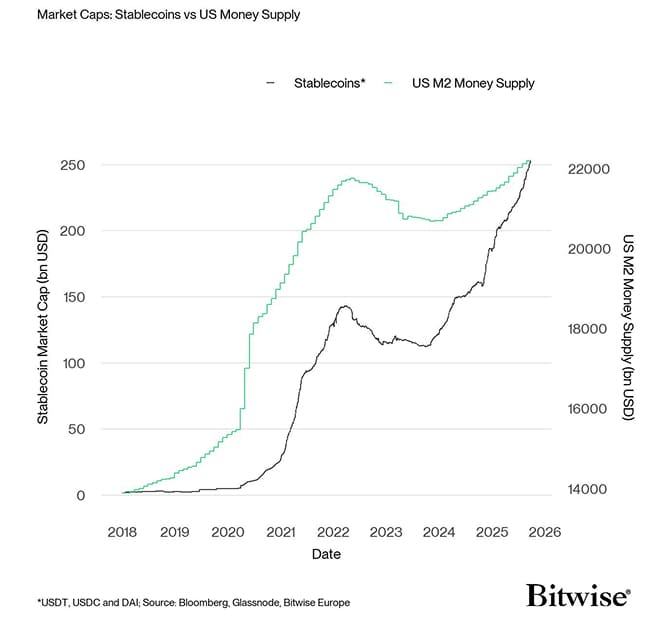
Performance
Cryptoasset performance in September were unusually strong, defying the negative seasonality pattern of bitcoin. Historically speaking, performance-wise, September tends to be the worst month for bitcoin with an average monthly performance of around -4% since 2010 as highlighted in our latest Crypto Market Compass report as well.
However, unlike August, the capital rotation from bitcoin to ether and other alts came to a halt as most altcoins underperformed bitcoin in September. Ether also underperformed bitcoin significantly in September. Bitcoin's market cap dominance also reclaimed 59% in September – up almost 2%-points compared to August.
Crypto market sentiment was mostly bearish while cross asset sentiment (measured by our own Cross Asset Risk Appetite Index) continued to be bullish – a notable divergence. Another notable divergence could be observed between Gold and Bitcoin. Bitcoin's performance has significantly trailed gold's performance in September – this could be due to differing macro factors influencing both hard assets:
While Bitcoin's performance has been mostly influenced by changes in global growth expectations, gold's performance has been mostly influenced by changes in monetary policy & US Dollar expectations (see charts in this post as well). This might also explain why bitcoin has recently diverged from the positive trend in global money supply as well. However, it is worth highlighting that changes in global growth expectations tend to follow changes in monetary policy expectations. This means that improving global growth expectations are likely going to provide a renewed tailwind for bitcoin's rally. Our base case is that the improvement in monetary policy and financial conditions induced by the continuation of the Fed's rate cutting cycle will prolong the current bull market well into 2026.
Cross Asset Performance (YtD)
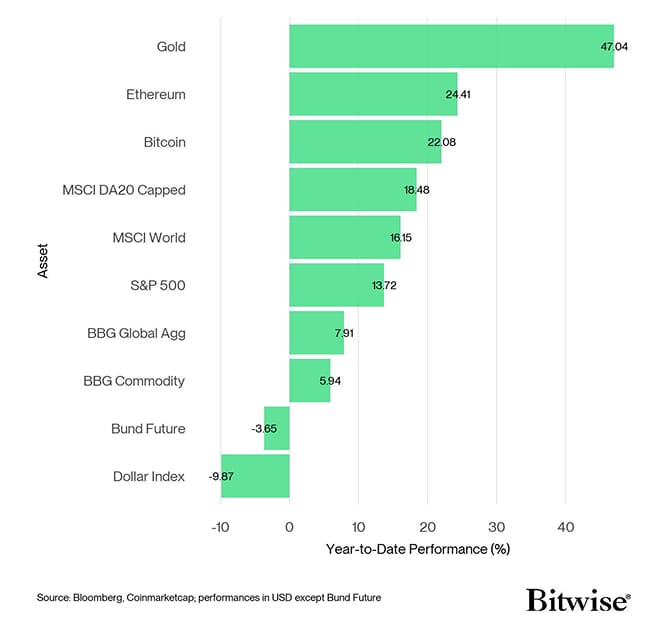 Source: Bloomberg, Coinmarketcap; performances in USD except Bund Future
Cross Asset Performance (MtD)
Source: Bloomberg, Coinmarketcap; performances in USD except Bund Future
Cross Asset Performance (MtD)
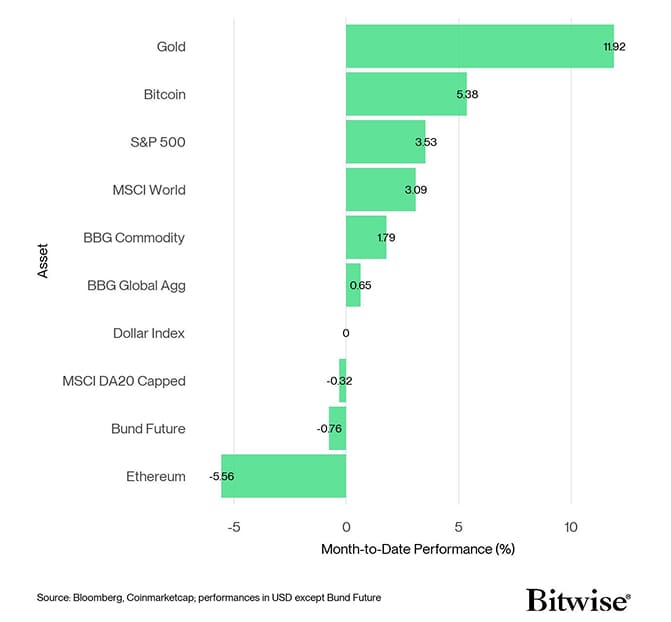 Source: Bloomberg, Coinmarketcap; performances in USD except Bund Future
Bitwise Europe Product Performance Overview (%)
Source: Bloomberg, Coinmarketcap; performances in USD except Bund Future
Bitwise Europe Product Performance Overview (%)
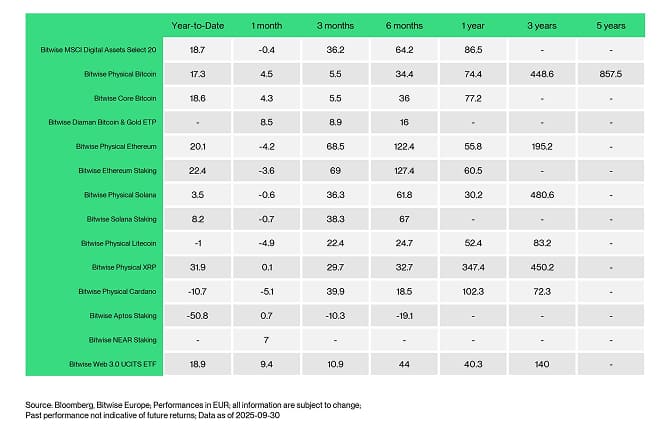 Source: Bloomberg, Bitwise Europe; Performances in EUR; all information are subject to change; past performance not indicative of future returns; Data as of 2025-09-30
Source: Bloomberg, Bitwise Europe; Performances in EUR; all information are subject to change; past performance not indicative of future returns; Data as of 2025-09-30
A closer look at our product performances also reveals that bitcoin outperformed most altcoins in September. The Bitwise Diaman Bitcoin & Gold ETP (BTCG) was the main outperformer due to the strong performance of gold in September.
Performance dispersion among altcoins increased slightly implying less correlation between bitcoin's performance and those of alts. However, only 20% of our tracked altcoins managed to outperform bitcoin on a monthly basis.
Bottom Line: Despite September's historical reputation as bitcoin's weakest month, the asset surprised to the upside, significantly outperforming ether and most altcoins, but still diverging from gold's strength. While short-term sentiment remains mixed, improving monetary policy and financial conditions are set to extend bitcoin's structural bull market well into 2026.
Macro Environment
Last month, the Federal Reserve has delivered its first 25 bps rate cut of the year - a move that was fully anticipated by markets. Bitcoin's muted price action at first suggested this was largely a “sell-the-news” event. A contributing factor could be the $1.6bn in FTX creditor distributions by late September, which may have added near-term selling pressure.
That said, we continue to see the Fed's easing cycle as a major medium-term tailwind for bitcoin and crypto assets.
History is clear: Fed rate-cutting cycles have often aligned with powerful bitcoin rallies as highlighted in one of our recent weekly Crypto Market Compass reports.
The drivers are threefold:
- Rate cuts usually steepen the yield curve; a dynamic tied to faster money supply growth. Bitcoin, one of the most responsive gauges of global liquidity expansion, tends to thrive in this backdrop. Global money supply has already pushed to new all-time highs and is still rising.
- Bitcoin has a positive historical correlation with market-based inflation expectations especially since Covid. Any renewed uptrend here should further support BTC.
- Real yields are set to decline as inflation accelerates, meaning looser financial conditions-a classically favourable environment for bitcoin.
We have highlighted the strong positive correlation between the steepness of the US Treasury curve and M1 money supply growth in our previous Bitcoin Macro Investor report in September as well.
Crucially, the Fed is cutting against a backdrop of weakening labour market data while headline inflation still sits at 2.9%. By easing under these conditions, the Fed is implicitly signalling tolerance for a higher inflation regime - likely closer to 3%.
Looking ahead, at the time of writing this report, Fed Funds Futures assign an 80% probability of another 50 bps in cuts by year-end, consistent with the “dot plot.” Moreover, new FOMC member Stephen Miran has projected as much as 125 bps of cuts, suggesting the balance of risks is skewing more dovish. The market is generally following the forward guidance by the Fed's latest median projections very closely.
The key to understand though is that the net result of falling rates and rising inflation expectations will most likely be lower real yields which signals a looser stance of monetary policy going forward.
The reason is that real yields tend to be one of the best single indicators for the stance of monetary policy. Lower real yields signal an easing in monetary policy while higher real yields tend to signal a tightening in monetary policy.
Note that the change in real yields is inverted in the following chart:
Monetary Policy Pricing vs US 10yr Real Yield
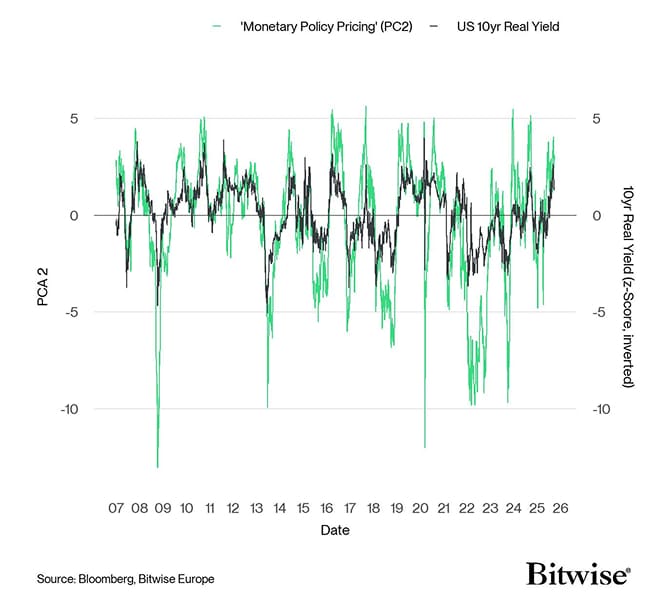
US real yields generally remain relatively high although they have been declining since late 2023 a bit. Higher inflation expectations and lower nominal yields through Fed rate cuts could set the stage for a sustained decline in US real yields over the medium term. This could further entice investors to look for alternative investments to avoid a gradual erosion of their purchasing power.
In any case, a looser stance of monetary policy is generally bullish for bitcoin because it tends to ease overall financial conditions as well.
Loose monetary policy directly eases financial conditions
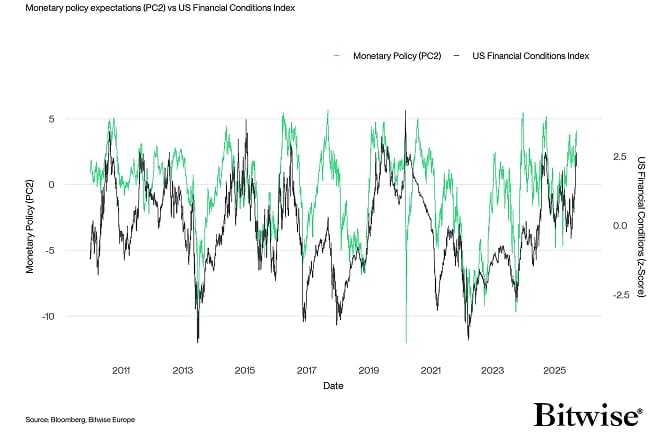
Bitcoin generally tends to thrive in an environment of easing financial conditions and tends to suffer in an environment of tightening financial conditions.
Easy financial conditions continue to support bitcoin
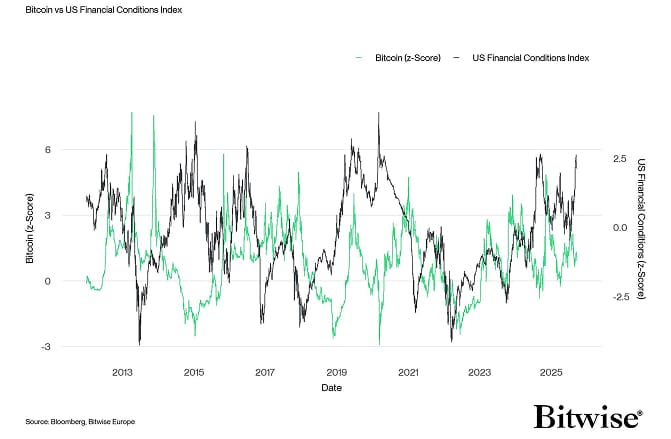
Based on the previous observations made above, we are most likely entering an environment of sustained easing in financial conditions.
In this context, it is worth noting that global growth factors still appear to be dominating bitcoin's performance from a pure quantitative perspective. This can be seen in our macro factor model which suggests that almost 90% of bitcoin's performance has been explained by changes in global growth expectations – not monetary policy expectations – over the past 6 months.
How much of Bitcoin's performance can be explained by macro factors?
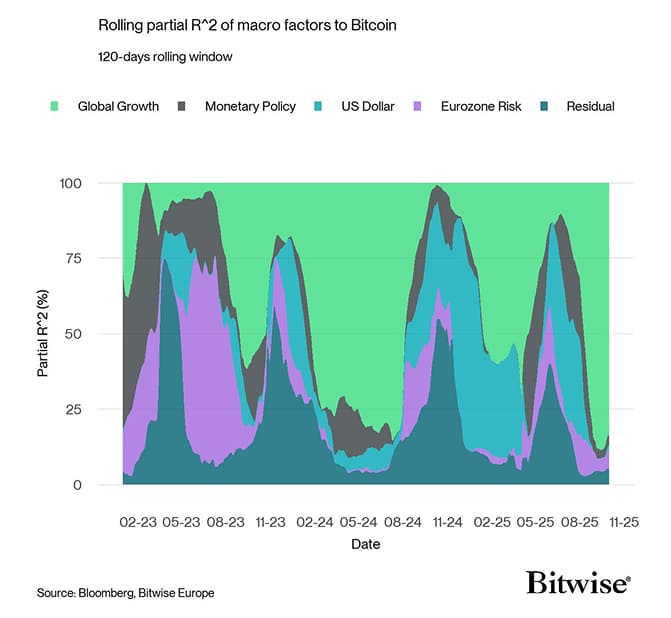 Source: Bloomberg, Bitwise Europe
Source: Bloomberg, Bitwise Europe
These market-based global growth expectations tend to be highly correlated with changes in leading business cycle indicators like the ISM Manufacturing Index.
The good news is that the ISM Manufacturing Index will likely recover swiftly based on the positive earnings revisions we have seen over the past couple of months. This also suggests that the ISM could significantly surprise to the upside.
US earnings revisions suggest that the ISM will recover swiftly
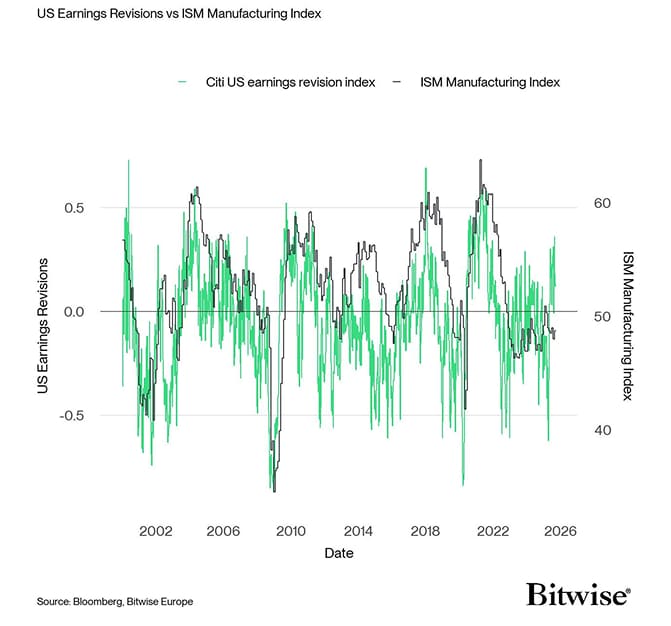
We have outlined the key reasons for this swift recovery - mostly centring around global monetary easing and liquidity growth – in our previous monthly report here.
It is also important to underscore that improvements in monetary policy expectations tend to lead improvements in global growth expectations. That's why we expect Fed rate cuts to support positive global growth expectations well into 2026.
It is generally key to understand the following dynamics:
- The Fed is easing into stagflation.
- Inflation is re-accelerating, with CPI inflation way above the Fed's 2% inflation target
- Financial repression/negative real yields are back on the horizon.
- Treasuries lose appeal, scarce assets (like bitcoin) gain.
- Cuts will steepen the curve, turbocharging money supply growth and inflation.
- Bitcoin benefits from both higher inflation expectations and looser policy.
Meanwhile, global money supply continues to make new all-time highs which implies higher bitcoin prices as well. Another indicator which also signals an increase in global liquidity is stablecoin market caps.
Aggregate stablecoin market caps have been making new all-time highs every day which is consistent with the observation that macro liquidity is increasing (Chart-of-the-Month):
Increasing stablecoin market caps are consistent w/ increasing macro liquidity

Bottom Line: The Fed's renewed easing cycle, set against rising inflation expectations and expanding global liquidity, points to a medium-term bullish backdrop for bitcoin. With real yields declining, money supply growth accelerating, and global growth expectations turning up, conditions are aligning for crypto assets to benefit meaningfully from looser financial conditions.
On-Chain Developments
September's performance was also heavily influenced by elevated selling pressure by whales. More specifically, bitcoin whales have distributed around 150k BTC since late August based on aggregate whale holdings that excludes miner and exchange wallets.
Nonetheless, Glassnode data show that transfer volumes from whale wallets to exchanges have gradually dissipated over the past couple of weeks which implies a decline in whale selling.
Broadly speaking, there are two major competing forces at play for bitcoin right now –
Major long-term holders have been distributing bitcoins while institutions have continued to accumulate. For instance, the percentage of supply last active 2+ years ago has been trending lower since late 2024 already. Meanwhile, the percentage of supply held by long-term holders (i.e. those with a holding period of more than 155 days) has also declined more recently.
That being said, the percentage of bitcoin supply held by institutions – public companies and bitcoin ETPs – continues to climb and is already close to 12.5%.
In other words, almost every 8th bitcoin that will ever exist is already controlled by an institutional investor.
Funds & Public Companies Now Hold close to 12.5% of All Bitcoin
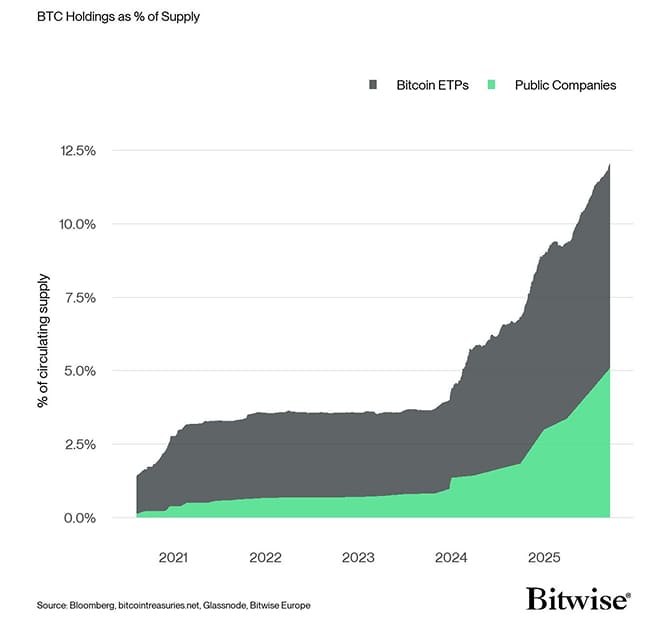
Companies like Strategy (MSTR) or Metaplanet (3350 JP) have continued buying more recently while global bitcoin ETPs have continued to experience net inflows.
So, “Bitcoin OGs” (multi-year Bitcoin holders) are bailing out, driving down Long-Term Holder metrics. Meanwhile, institutions (ETPs & companies companies) are buying in.
That's why we also continue to see a continued decline in liquid and highly liquid supply (on exchanges) which is exacerbated by ongoing institutional accumulation of bitcoin. This tends to be a strong tailwind for bitcoin going into the fourth quarter.
Bitcoin: Price vs (Highly) Liquid Supply
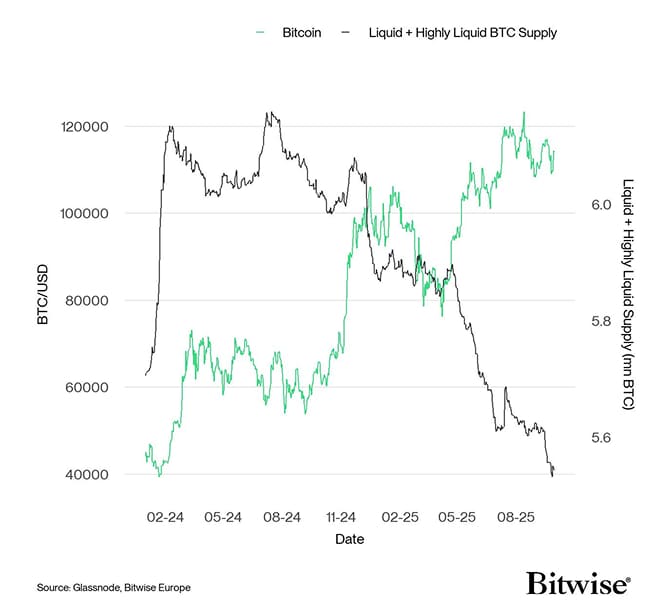
In the context of long-term holders, it is worth noting that bull cycles are generally characterised by a decline in relative long-term holder supply and an increase in short-term holder supply as new investors and fresh capital flock into the market.
This is exacerbated by signficant whale exchange outflows – these might be due to internal exchange transfers but the aggregate exchange supply still appears to be trending downwards.
For the time being, we are also observing a positive momentum in “apparent demand” which is also derived from changes in long-term holder supply (i.e. coins held for at least 1 year).
Bitcoin: 'Apparent Demand'*
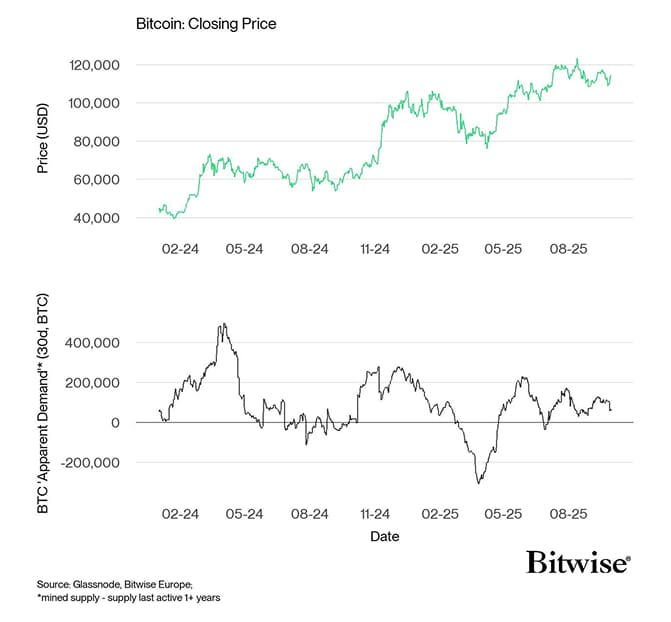
As far as selling pressure is concerned, we are also seeing increasing evidence for “seller exhaustion”.
In fact, we might already be in the process of bottoming out as highlighted in our recent Crypto Market Compass as well. For instance, our Cryptoasset Sentiment Index has hit overbought levels on an intraday basis last week twice and the Crypto Fear and Greed Index published by CFGI.io has even reached “extreme fear” levels on an intraday basis as well. This is equivalent to a -1 standard deviation in our hourly Cryptoasset Sentiment Index.
Cryptoasset Sentiment Index: Daily vs Hourly
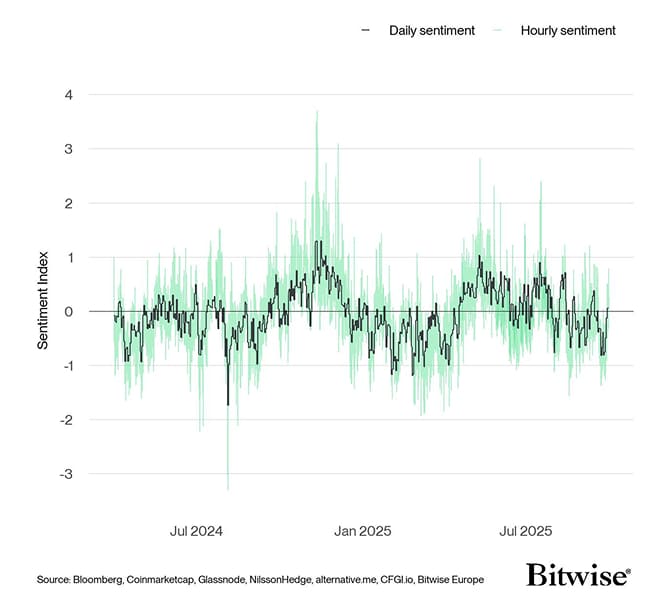
Bitcoin has shown relative resilience, holding around ~$108k - a level that also aligns with the short-term holder cost basis – this appears to provide a strong support for bitcoin right now as sellers are increasingly exhausted.
Bottom Line: Despite significant selling pressure by long-term holders, bitcoin remains relatively resilient due to ongoing outsized institutional demand and a decline in liquid supply (on exchanges). Bearish sentiment and on-chain metrics imply that sellers are becoming increasingly exhausted and signal that bitcoin might be in the process of bottoming out already.
Bottom Line
- Performance: Despite September’s historical reputation as bitcoin’s weakest month, the asset surprised to the upside, significantly outperforming ether and most altcoins, but still diverging from gold’s strength. While short-term sentiment remains mixed, improving monetary policy and financial conditions are set to extend bitcoin’s structural bull market well into 2026.
- Macro: The Fed’s renewed easing cycle, set against rising inflation expectations and expanding global liquidity, points to a medium-term bullish backdrop for bitcoin. With real yields declining, money supply growth accelerating, and global growth expectations turning up, conditions are aligning for crypto assets to benefit meaningfully from looser financial conditions.
- On-Chain:Despite significant selling pressure by long-term holders, bitcoin remains relatively resilient due to ongoing outsized institutional demand and a decline in liquid supply (on exchanges). Bearish sentiment and on-chain metrics imply that sellers are becoming increasingly exhausted and signal that bitcoin might be in the process of bottoming out already.
Appendix
Cryptoasset Market Overview
Global Cryptoasset Market Caps
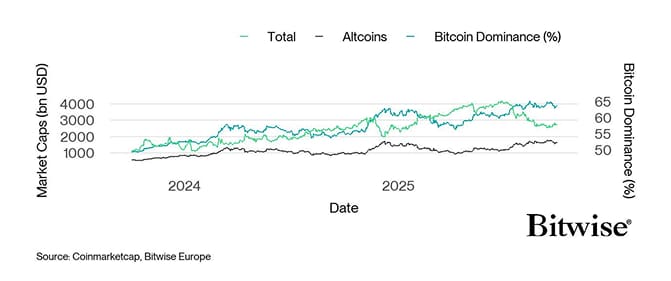 Source: Glassnode, Bitwise Europe
Bitcoin Performance
Source: Glassnode, Bitwise Europe
Bitcoin Performance
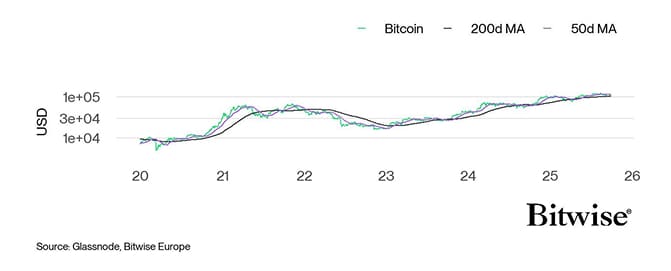 Source: Glassnode, Bitwise Europe
Ethereum Performance
Source: Glassnode, Bitwise Europe
Ethereum Performance
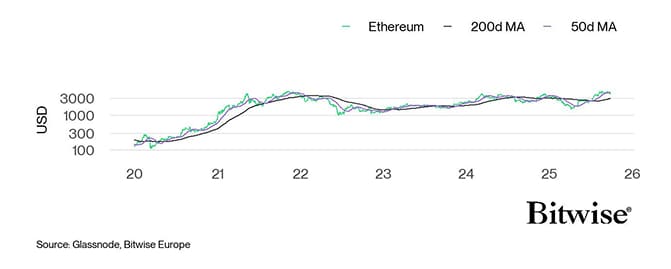 Source: Glassnode, Bitwise Europe
Ethereum vs Bitcoin Relative Performance
Source: Glassnode, Bitwise Europe
Ethereum vs Bitcoin Relative Performance
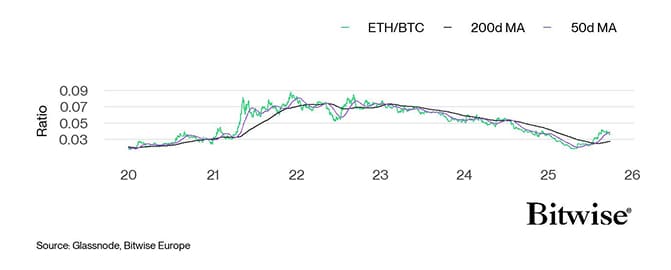 Source: Glassnode, Bitwise Europe
Altseason Index
Source: Glassnode, Bitwise Europe
Altseason Index
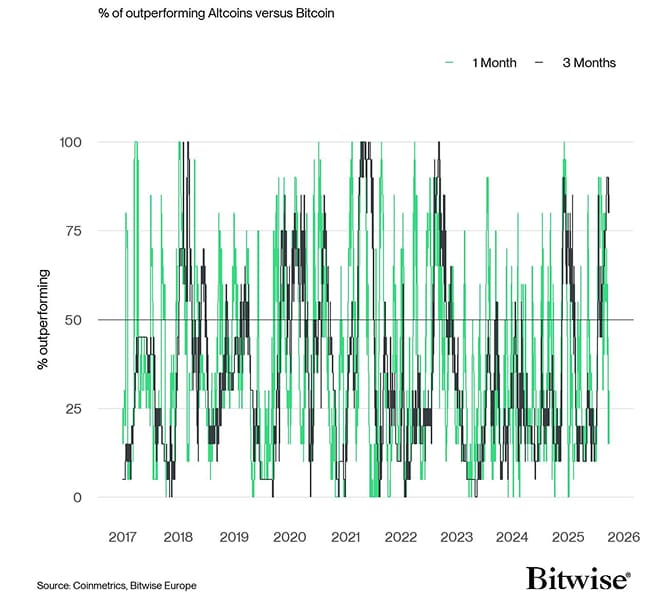 Source: Coinmetrics, Bitwise Europe
Bitcoin vs Crypto Dispersion Index
Source: Coinmetrics, Bitwise Europe
Bitcoin vs Crypto Dispersion Index
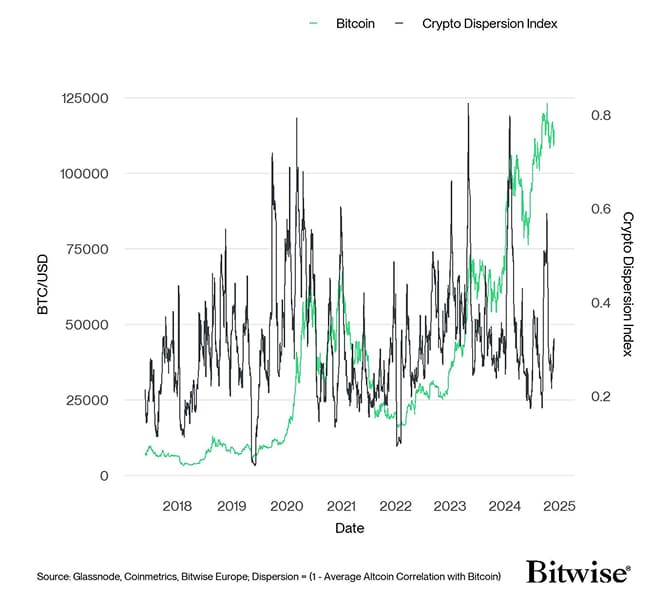 Source: Glassnode, Coinmetrics, Bitwise Europe; Despersion = (1 - Average Altcoin Correlation with Bitcoin)
Source: Glassnode, Coinmetrics, Bitwise Europe; Despersion = (1 - Average Altcoin Correlation with Bitcoin)
Cryptoassets & Macroeconomy
Macro Factor Pricing
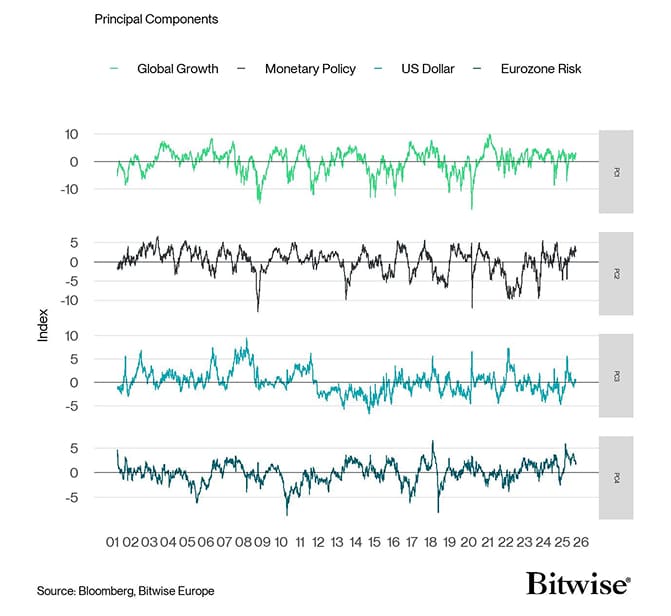 Source: Bloomberg, Bitwise Europe
How much of Bitcoin's performance can be explained by macro factors?
Source: Bloomberg, Bitwise Europe
How much of Bitcoin's performance can be explained by macro factors?
 Source: Bloomberg, Bitwise Europe
Source: Bloomberg, Bitwise Europe
Cryptoassets & Multiasset Portfolios
Multiasset Performance with Bitcoin (BTC)
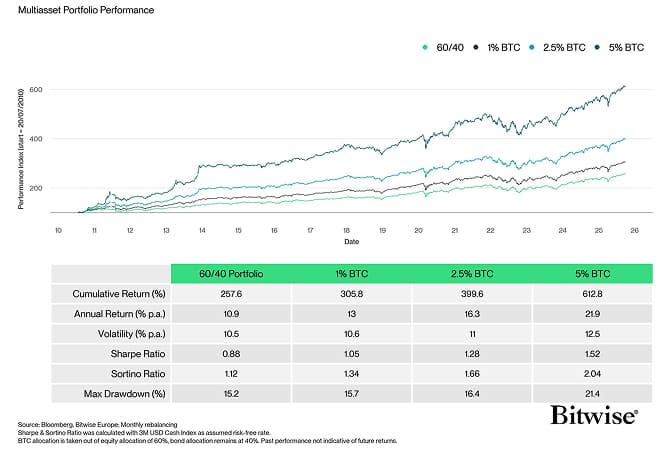 Source: Bloomberg, Bitwise Europe; Monthly rebalancing; Sharpe Ratio was calculated with 3M USD Cash Index as assumed risk-free rate; BTC allocation is taken out of equity allocation of 60%, bond allocation remains at 40%; Past performance not indicative of future returns.
Rolling correlation: S&P 500
Source: Bloomberg, Bitwise Europe; Monthly rebalancing; Sharpe Ratio was calculated with 3M USD Cash Index as assumed risk-free rate; BTC allocation is taken out of equity allocation of 60%, bond allocation remains at 40%; Past performance not indicative of future returns.
Rolling correlation: S&P 500
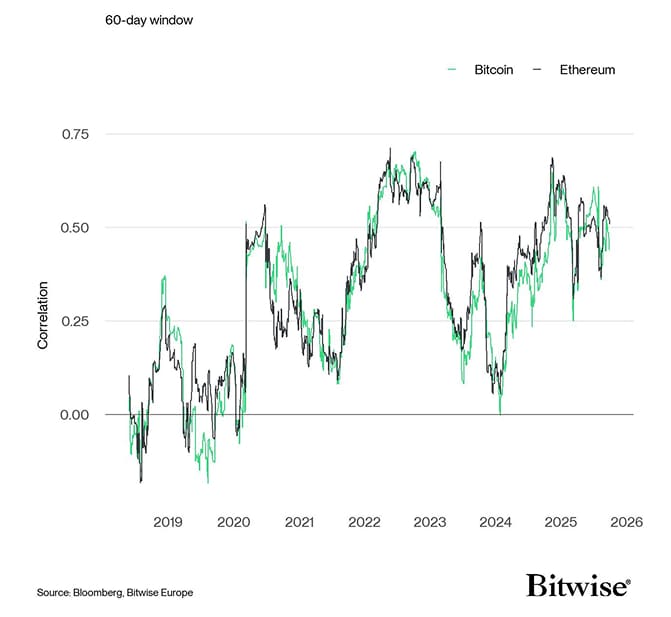 Source: Bloomberg, Bitwise Europe
Rolling correlation: Bund Future
Source: Bloomberg, Bitwise Europe
Rolling correlation: Bund Future
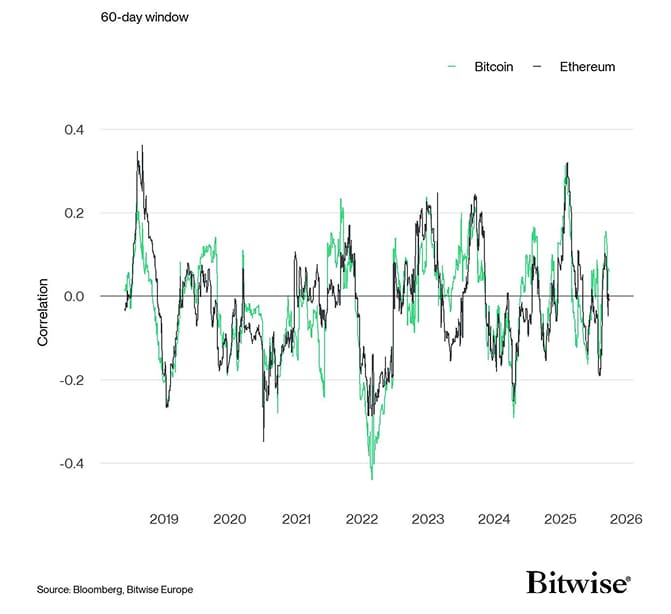 Source: Bloomberg, Bitwise Europe
Rolling correlation: Gold
Source: Bloomberg, Bitwise Europe
Rolling correlation: Gold
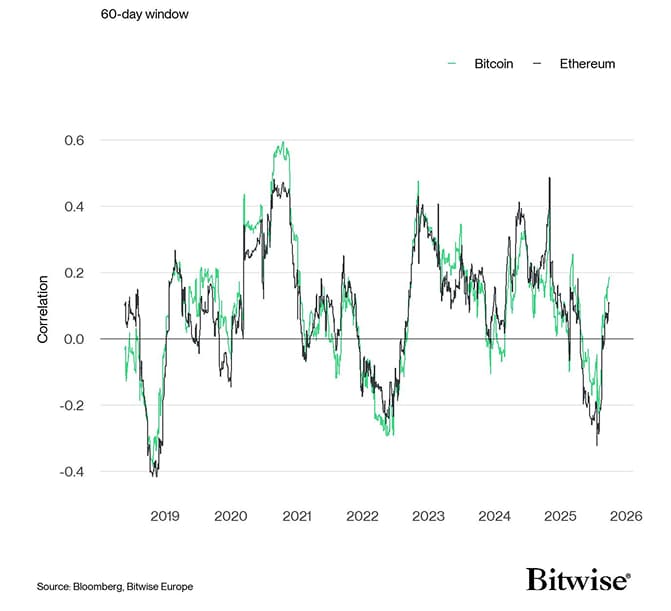 Source: Bloomberg, Bitwise Europe
Rolling correlation: Dollar Index (DXY)
Source: Bloomberg, Bitwise Europe
Rolling correlation: Dollar Index (DXY)
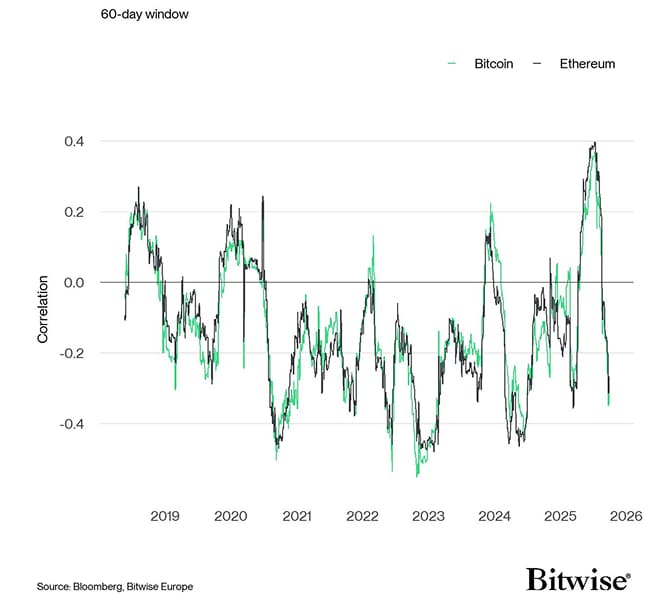 Source: Bloomberg, Bitwise Europe
Cross Asset Correlation Matrix
Source: Bloomberg, Bitwise Europe
Cross Asset Correlation Matrix
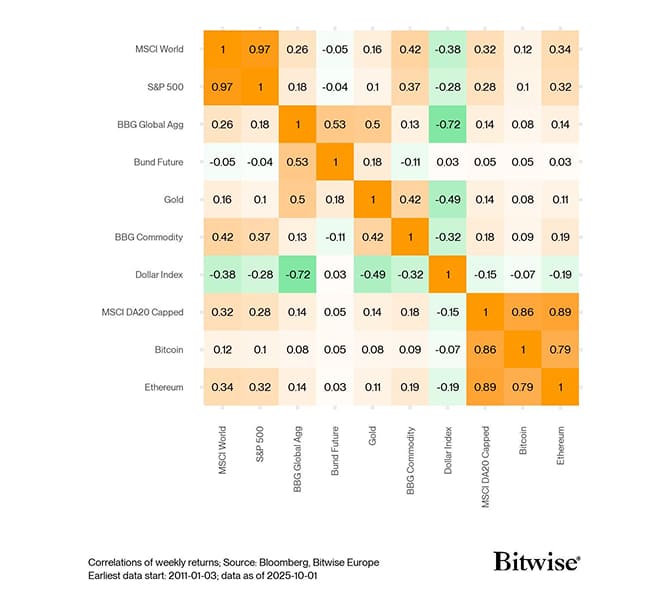 Source: Correlations of weekly returns; Source: Bloomberg, ETC Group earliest data start: 2011-01-03; data as of 2025-10-01
Source: Correlations of weekly returns; Source: Bloomberg, ETC Group earliest data start: 2011-01-03; data as of 2025-10-01
Cryptoasset Valuations
Bitcoin: Price vs Composite Valuation Indicator
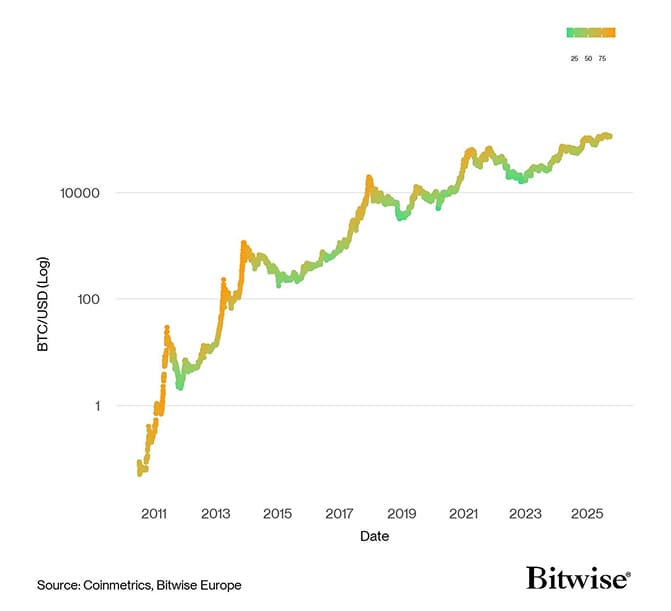 Source: Coinmetrics, Bitwise Europe
Bitcoin: Composite Valuation Indicator
Source: Coinmetrics, Bitwise Europe
Bitcoin: Composite Valuation Indicator
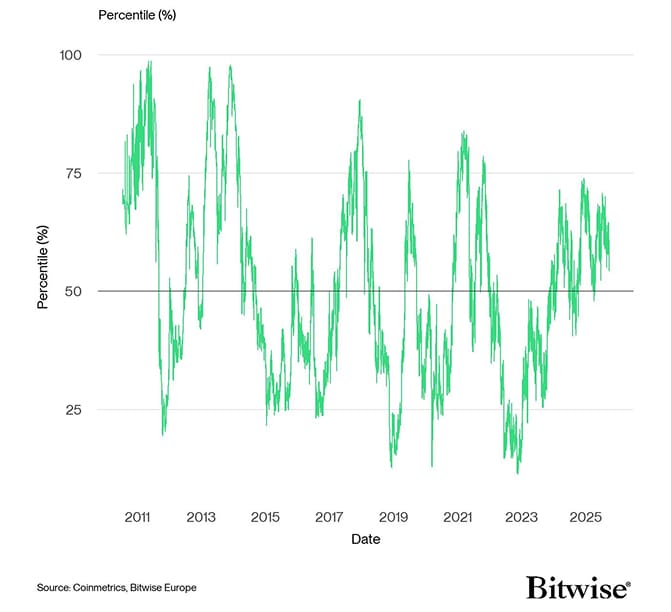 Source: Coinmetrics, Bitwise Europe
Bitcoin: Valuation Metrics
Source: Coinmetrics, Bitwise Europe
Bitcoin: Valuation Metrics
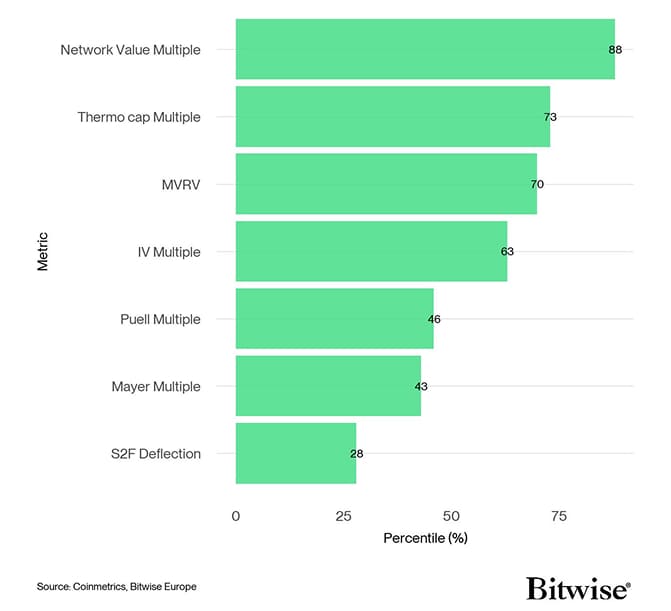 Source: Coinmetrics, Bitwise Europe
Source: Coinmetrics, Bitwise Europe
On-Chain Fundamentals
Bitcoin: Price vs Network Activity Index
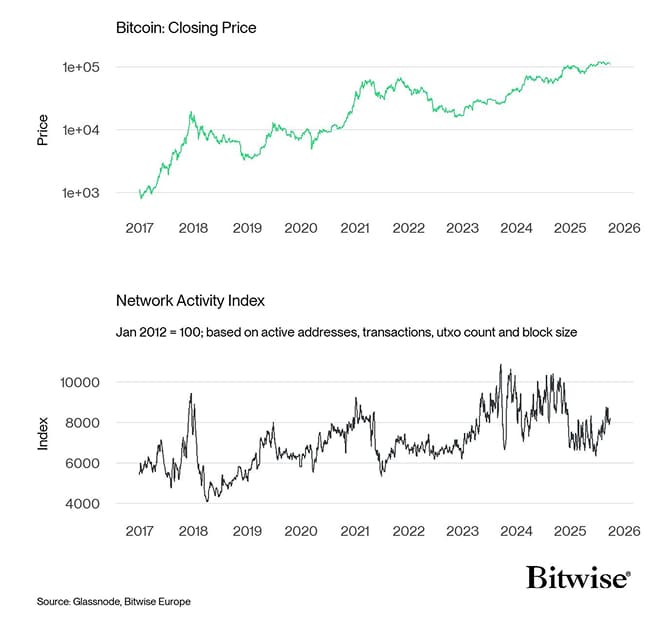 Source: Glassnode, Bitwise Europe
Bitcoin: Closing Price
Source: Glassnode, Bitwise Europe
Bitcoin: Closing Price
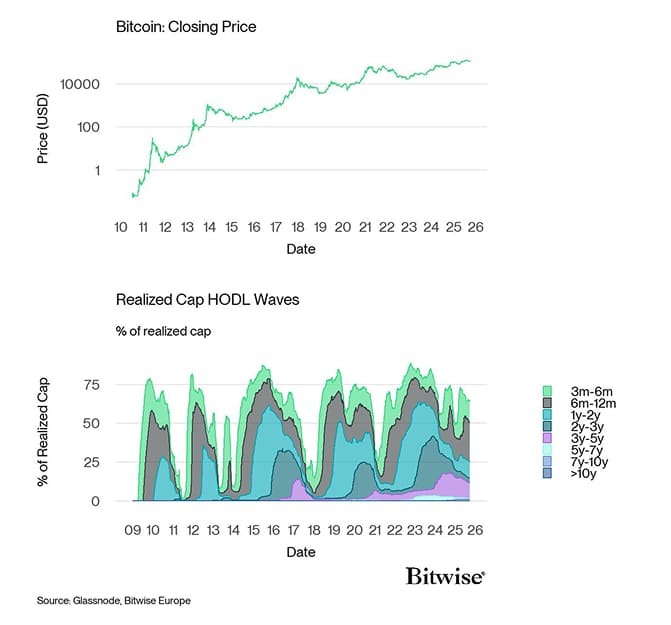 Source: Glassnode
Bitcoin's supply scarcity is more pronounsed that during the last cycle
Source: Glassnode
Bitcoin's supply scarcity is more pronounsed that during the last cycle
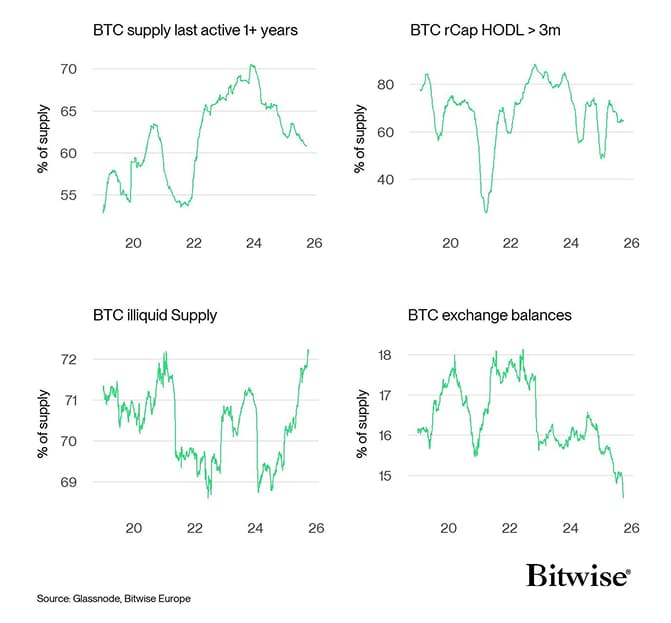 Source: Glassnode, Bitwise Europe
Bitcoin Long-term Holder (LTH) Dashboard
Source: Glassnode, Bitwise Europe
Bitcoin Long-term Holder (LTH) Dashboard
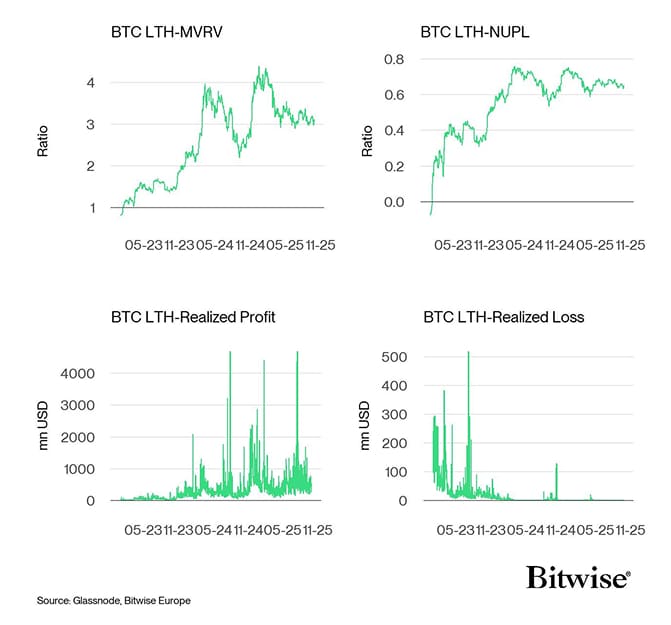 Source: Glassnode, Bitwise Europe
Bitcoin Short-term Holder (STH) Dashboard
Source: Glassnode, Bitwise Europe
Bitcoin Short-term Holder (STH) Dashboard
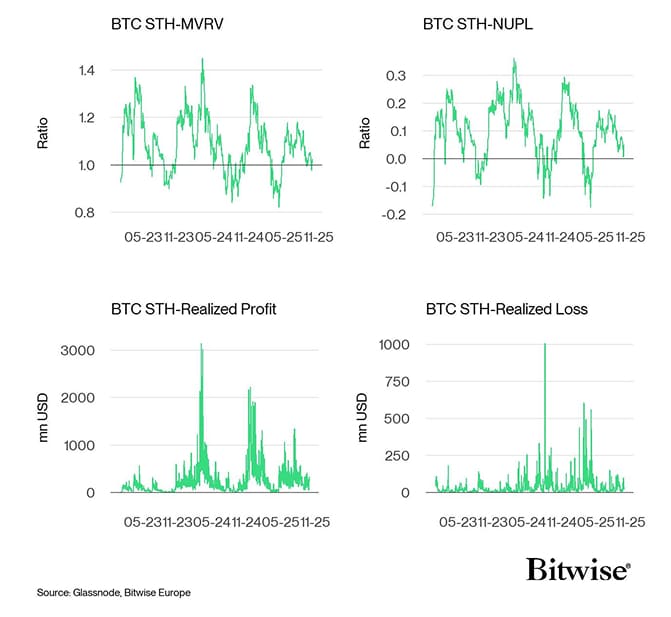 Source: Glassnode, Bitwise Europe
Bitcoin: Price vs Average Accumulatio Score
Source: Glassnode, Bitwise Europe
Bitcoin: Price vs Average Accumulatio Score
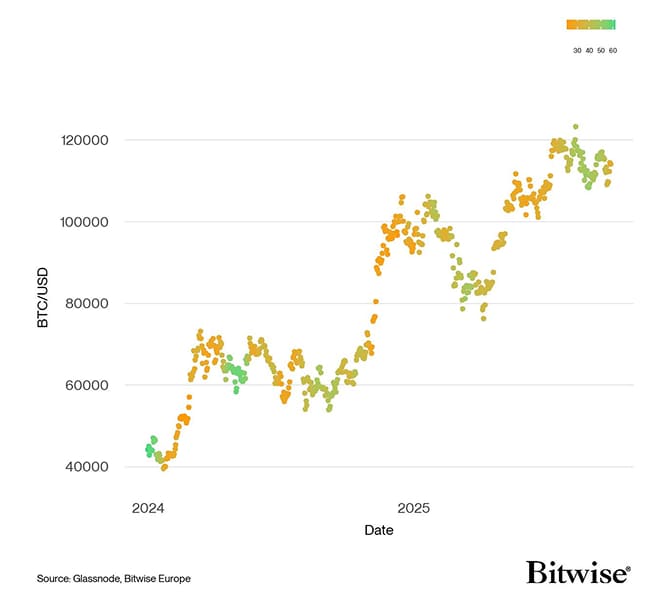 Source: Glassnode, ETC Group
Bitcoin Accumulation Score
Source: Glassnode, ETC Group
Bitcoin Accumulation Score
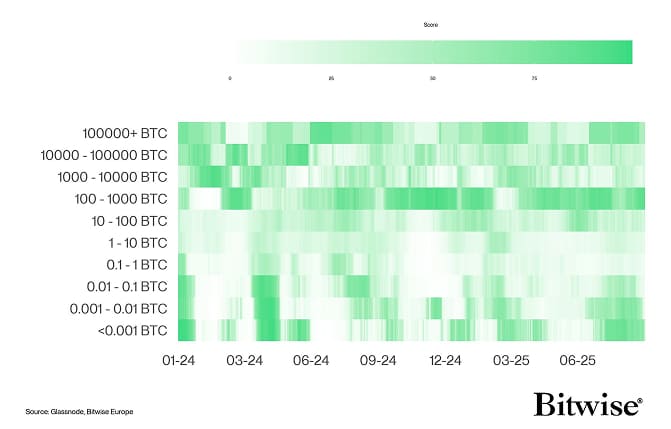 Source: Glassnode, Bitwise Europe
Bitcoin: Post-Halving Performance
Source: Glassnode, Bitwise Europe
Bitcoin: Post-Halving Performance
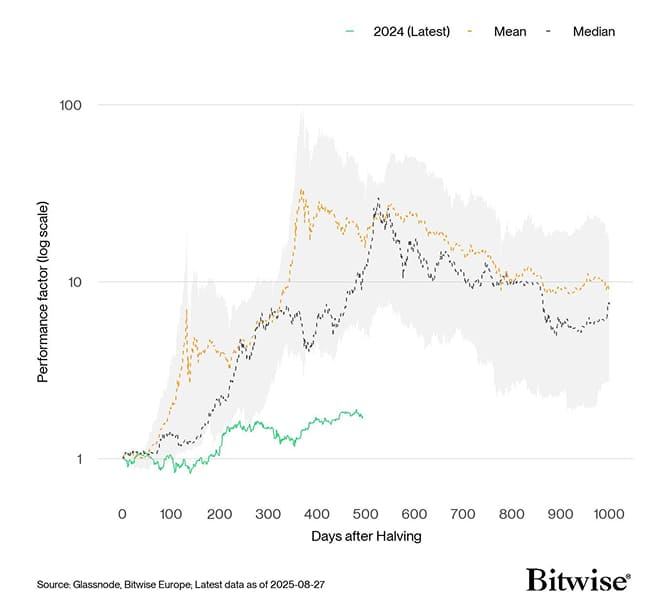 Source: Glassnode, Bitwise Europe; Results based on the previous Halvings in 2012, 2016, and 2020
Bitcoin: Steady increase in scarcity will provide a tailwind for price appreciations
Source: Glassnode, Bitwise Europe; Results based on the previous Halvings in 2012, 2016, and 2020
Bitcoin: Steady increase in scarcity will provide a tailwind for price appreciations
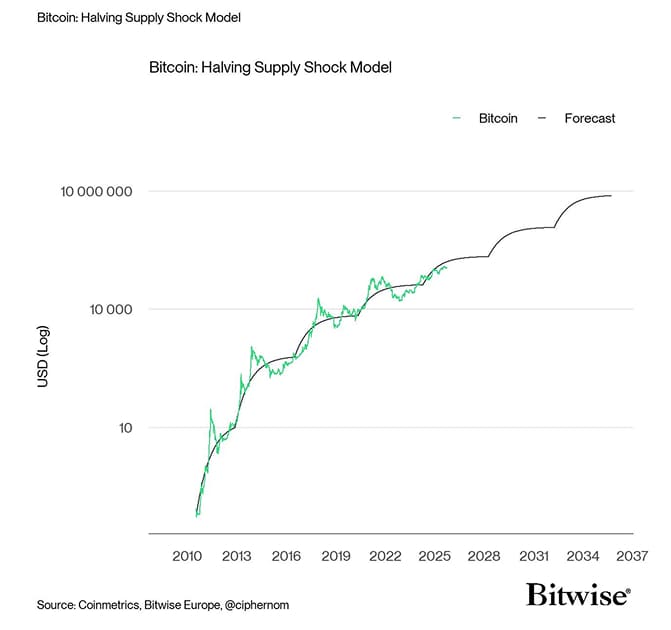 Source: Coinmetrics, Bitwise Europe; @ciphernom
Source: Coinmetrics, Bitwise Europe; @ciphernom
Important information:
This article does not constitute investment advice, nor does it constitute an offer or solicitation to buy financial products. This article is for general informational purposes only, and there is no explicit or implicit assurance or guarantee regarding the fairness, accuracy, completeness, or correctness of this article or the opinions contained therein. It is advised not to rely on the fairness, accuracy, completeness, or correctness of this article or the opinions contained therein. Please note that this article is neither investment advice nor an offer or solicitation to acquire financial products or cryptocurrencies.
Before investing in crypto ETPs, potentional investors should consider the following:
Potential investors should seek independent advice and consider relevant information contained in the base prospectus and the final terms for the ETPs, especially the risk factors mentioned therein. The invested capital is at risk, and losses up to the amount invested are possible. The product is subject to inherent counterparty risk with respect to the issuer of the ETPs and may incur losses up to a total loss if the issuer fails to fulfill its contractual obligations. The legal structure of ETPs is equivalent to that of a debt security. ETPs are treated like other securities.

